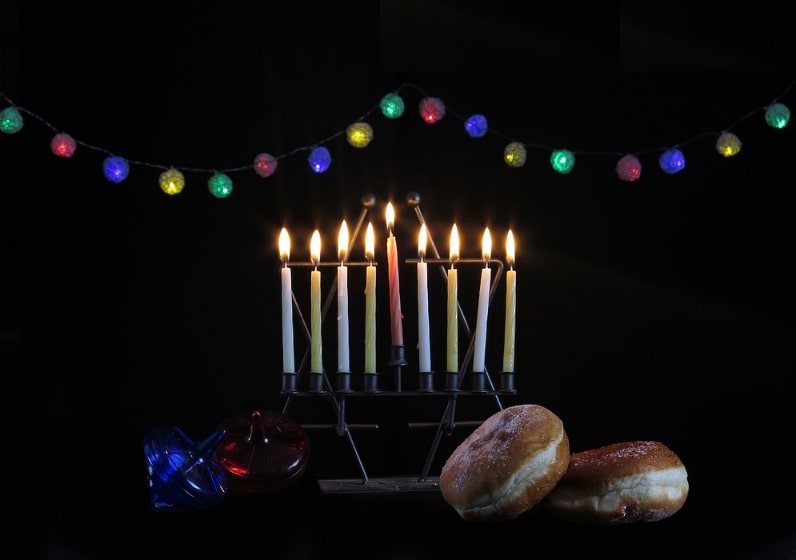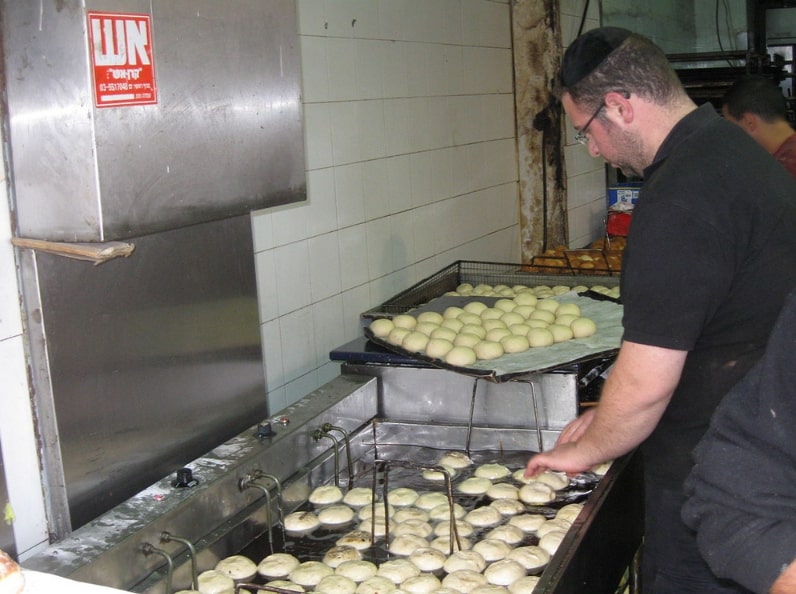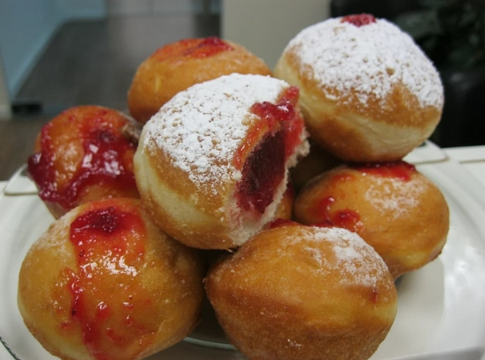Introduction: In this article – with Hanukkah beginning at sundown today – Gena Philibert-Ortega searches old newspapers to find sufganiyot recipes. Gena is a genealogist and author of the book “From the Family Kitchen.”
One tradition that goes with Hanukkah is food. Fried foods are symbolic of the miracle of the Temple oil. During the retaking of Jerusalem, from the period of the Second Temple (~516 BCE-70CE) the Jews cleared out the Temple and rededicated it by lighting the menorah. They used the one container (cruse) of oil that had not been defiled to light the menorah – but instead of that oil lasting the expected one night, it lasted eight nights.* Fried foods are served during Hanukkah as a reminder of that miracle.
Latkes (potato pancakes) are one fried treat served during Hanukkah, but another has a decidedly sweet taste: Sufganiyot (jelly doughnuts).

These fried donuts are round, filled with jelly or jam, and topped with powdered sugar. They are sometimes referred to as “Israeli Doughnuts” because they are eaten in Israel for Hanukkah. While not common in the United States until the latter 20th century, sufganiyot recipes originate from 16th century Europe.
Of course, you could skip the process of making your own doughnuts by buying jelly doughnuts at a store or bakery, but Hanukkah is a great time to involve kids in kitchen activities. Making jelly doughnuts is one way kids can customize their desserts to include fillings that are their favorites. Keep in mind that making doughnuts as directed in many of these recipes is a big undertaking that will require time and the equipment to fry the doughnuts. Kids should be supervised when cooking and, depending on their ages, will need an adult to fry and handle the hot oil.

If you are not used to frying foods, consider these tips from the Staten Island Sunday Advance. This article includes everything from which oil and how much to use to what to do with it when you’re done.
These sufganiyot are topped off with a chocolate/vanilla cream.
Sufganiyot Recipes
The first recipe I found for sufganiyot in GenealogyBank’s Historical Newspaper Archives is from 1976. That recipe is different than later recipes as it calls for the dough to be cut into a circle with a glass (sort of like making a biscuit) and then jelly or jam placed in between two circles. After the two circles are joined together, they are left to rise and then ready to be fried.
This San Francisco Chronicle recipe for sufganiyot is adapted from a cookbook. This recipe makes 18 doughnuts, and the batter includes lemon zest and cinnamon that would be a nice way to add some flavor. You fill the doughnut with a tart jelly or jam of your choice.
While it seems like most sufganiyot recipes are similar, these next two newspaper recipes differ in that one calls for yeast and the other for a soft cheese. Both suggest the filling could be made from cranberry, strawberry or raspberry jam.
If you’re interested in making the jam to fill the doughnut, consider a refrigerator jam. Refrigerator jams are easy to make and do not require you to do any canning to store the jam. Strawberry Refrigerator Jam is a popular recipe.
Happy Hanukkah!
If you haven’t tried sufganiyot yet, this might be a good time to add something different to your Hanukkah party. No matter what you choose to eat, have a wonderful Hanukkah and a Happy New Year!
Explore over 330 years of newspapers and historical records in GenealogyBank. Discover your family story! Start a 7-Day Free Trial
Note on the header image: classic Hanukkah sufganiyot filled with strawberry jelly and powdered sugar. Credit: Noam Furer; Wikimedia Commons.
* “Miracle of the Cruse of Oil,” Wikipedia (https://en.wikipedia.org/wiki/Miracle_of_the_cruse_of_oil#: accessed 6 December 2023).
